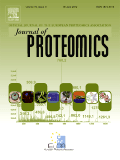
BIOCHIMICA ET BIOPHYSICA ACTA-PROTEINS AND PROTEOMICS
Scope & Guideline
Illuminating the Path of Protein Functionality
Introduction
Aims and Scopes
- Protein Structure and Function:
Research in this area involves elucidating the three-dimensional structures of proteins and understanding how these structures relate to their biological functions. This includes studies on conformational changes, dynamics, and interactions with other biomolecules. - Proteomics and Mass Spectrometry:
The journal publishes articles on proteomic techniques, particularly those utilizing mass spectrometry for the analysis of protein expression, post-translational modifications, and interactions. This area emphasizes the development and refinement of proteomic methodologies. - Biophysical Characterization of Proteins:
This scope encompasses the use of biophysical techniques, such as NMR, circular dichroism, and fluorescence spectroscopy, to study the physical properties of proteins, including stability, folding kinetics, and interactions. - Molecular Mechanisms in Health and Disease:
Research exploring the roles of proteins in various biological processes and diseases, including neurodegenerative conditions, cancer, and infectious diseases, is a central focus, emphasizing the molecular basis of pathology. - Chemical Biology and Drug Development:
This area covers studies that investigate the interactions of proteins with small molecules, including drug discovery and the development of therapeutic agents targeting specific protein functions.
Trending and Emerging
- Liquid-Liquid Phase Separation:
An increasing number of studies are focusing on the role of liquid-liquid phase separation in cellular organization and protein aggregation, particularly in neurodegenerative diseases. This theme highlights the importance of understanding how proteins behave in crowded cellular environments. - Machine Learning and AI in Proteomics:
The application of machine learning techniques to predict protein interactions, folding, and stability is gaining momentum. This trend signifies a shift towards computational approaches that can complement experimental methods, enhancing the predictive power of proteomic studies. - Post-Translational Modifications (PTMs):
Research exploring the functional implications of PTMs is increasingly prevalent, reflecting their critical roles in regulating protein function and interactions. This emerging focus underscores the complexity of protein regulation in various biological contexts. - Protein-Protein Interactions and Networks:
There is a growing emphasis on studying protein-protein interactions and their implications in biological systems, including signal transduction and disease mechanisms. This trend highlights the importance of understanding proteins in the context of larger biological networks. - Therapeutic Target Identification:
The journal is seeing more studies aimed at identifying novel therapeutic targets through proteomic and structural analyses, particularly in the context of cancer and infectious diseases. This reflects an increasing interest in translating protein research into clinical applications.
Declining or Waning
- Traditional Enzymology:
While enzymology remains a core area, there has been a noticeable decline in studies focusing solely on classical enzyme kinetics without integration into broader biological contexts or proteomic approaches. The shift towards systems biology and integrative methods may be overshadowing traditional enzyme studies. - Basic Protein Expression Studies:
Research focused exclusively on the expression levels of proteins in isolated systems, without context to cellular or organismal function, has decreased. The emphasis has shifted towards more complex analyses that integrate protein expression with functional outcomes. - Single-Protein Studies:
The trend is moving away from isolated studies of single proteins towards more comprehensive analyses involving protein networks and interactions. This reflects a growing understanding of the complexity of biological systems and the need for holistic approaches.
Similar Journals

Biophysics Reviews
Transforming Fundamental Research into Real-World SolutionsBiophysics Reviews, published by AIP Publishing, is an emerging journal in the field of biophysics, aiming to bridge the gap between fundamental biophysical research and applied sciences. With an ISSN of 2688-4089, this journal provides a critical platform for the dissemination of high-quality reviews covering the interplay between biochemistry, molecular biology, biotechnology, and materials science. As of 2023, it provides essential insights for researchers and professionals interested in understanding biomolecular processes at a physical level. Although the journal is not currently open access, it is making strides in establishing its impact in the competitive landscape, as indicated by its Scopus rankings in various related fields, including biochemistry and bioengineering. With a focus on enhancing collaborations among scientists and practitioners, Biophysics Reviews is poised to become a vital resource for anyone looking to deepen their understanding of how biophysical principles can be applied to solve complex biological challenges.

PROTEIN SCIENCE
Transforming Research into Revolutionary DiscoveriesPROTEIN SCIENCE, published by Wiley, is a premier journal dedicated to the field of biochemistry, molecular biology, and medicine, boasting an impressive impact factor that reflects its influence and importance within the academic community. Established in 1992, the journal has continuously provided a platform for high-quality research, with a current classification in the top quartile (Q1) for its critical contributions to the understanding of protein structure and function, as well as its applications in health and disease. With a Scopus ranking placing it in the 91st percentile among its peers, PROTEIN SCIENCE publishes cutting-edge studies and reviews that are essential for researchers, professionals, and students seeking to advance their knowledge in protein research. Although it does not currently offer open access options, the journal remains dedicated to disseminating vital findings that support the ongoing advancements in molecular biology and biochemistry. Researchers can count on PROTEIN SCIENCE for consistently rigorous peer-reviewed content that fosters meaningful dialog and innovation in the life sciences.

ELECTROPHORESIS
Advancing the Frontiers of Electrophoretic ScienceELECTROPHORESIS, published by Wiley, stands as a premier journal dedicated to advancing the field of analytical chemistry, biochemistry, and clinical biochemistry. With an ISSN of 0173-0835 and an E-ISSN of 1522-2683, this journal has been a vital resource since its inception in 1980 and is poised to continue its journey through to 2024. Operating out of Germany, it holds a significant standing in the academic community, featuring in the Q2 category for Analytical Chemistry and in the Q3 tier for both Biochemistry and Clinical Biochemistry as of 2023. The journal ranks impressively within Scopus, occupying the 43rd position out of 156 in Analytical Chemistry and the 44th spot out of 117 in Clinical Biochemistry, ensuring its relevance and impact in these disciplines. Although it does not currently offer open access, ELECTROPHORESIS remains an essential publication for researchers, professionals, and students seeking cutting-edge insights and developments that influence the methodologies and technologies underpinning electrophoretic techniques.

Protein & Cell
Fostering Global Knowledge Exchange in Biochemical ResearchProtein & Cell, published by Oxford University Press, is a distinguished international journal focusing on cutting-edge research in the fields of biochemistry, biotechnology, cell biology, and drug discovery. This open access journal, active since 2014, is dedicated to disseminating innovative findings that advance our understanding of protein functions and cellular processes, making it an essential resource for researchers, professionals, and students alike. With an impressive 2023 impact factor reflected in its Q1 ranking across multiple categories such as Biochemistry, Drug Discovery, and Cell Biology, 'Protein & Cell' stands at the forefront of scientific research, driving collaboration and discussion in the scientific community. Researchers can access the journal freely online, fostering a global exchange of knowledge and contributing to significant advancements in medicine and biotechnology. Located in the United Kingdom, the journal strives to be a pivotal platform for impactful research that influences future studies and applications.

Journal of Proteomics
Transforming research with cutting-edge proteomic insights.Journal of Proteomics, published by Elsevier, is an esteemed peer-reviewed journal dedicated to advancing research in the field of proteomics, with broad implications for biochemistry and biophysics. Established in 2008, the journal has continuously evolved, embracing innovative methodologies and technologies that facilitate protein analysis from a variety of biological systems. With its current standing in the Q2 category for both biochemistry and biophysics as of 2023, it is recognized as a significant contributor to scientific literature. The journal publishes original research articles, reviews, and methodological advancements, providing invaluable insights for researchers, professionals, and students alike. Although it does not offer open access, the journal remains a crucial platform for disseminating knowledge that informs various applications, ranging from drug development to disease understanding. As it converges towards 2024, the Journal of Proteomics continues to solidify its role in shaping the future of proteomic research through rigorous scientific inquiry and innovation.

FEBS LETTERS
Pioneering New Ideas in Biochemistry and GeneticsFEBS LETTERS, published by Wiley, is a prestigious journal that has firmly established its place in the fields of biochemistry, biophysics, genetics, molecular biology, cell biology, and structural biology. With an esteemed history dating back to 1968, this journal continues to be a vital resource for researchers and professionals involved in the biological sciences. It boasts impressive quartile rankings, including Q1 statuses in several categories such as Biochemistry and Genetics, reflecting its high impact factor and significant contribution to scientific discourse. FEBS LETTERS provides a platform for innovative findings and critical reviews, fostering the exchange of knowledge and ideas within the scientific community. Although it operates under a subscription model, the journal ensures broad dissemination of groundbreaking research through its rigorous peer-review process. The vibrant discussions encouraged by articles published in FEBS LETTERS aim to inspire current and future generations of scientists to push the boundaries of biological understanding, making it an indispensable resource for anyone dedicated to advancing their knowledge in these dynamic fields.

BIOCHEMISTRY-MOSCOW
Championing Groundbreaking Studies in Life SciencesBIOCHEMISTRY-MOSCOW is a distinguished academic journal published by MAIK NAUKA/INTERPERIODICA/SPRINGER, focusing on pivotal research in the fields of biochemistry, biophysics, geriatrics, and broader medical sciences. Established in 1972, the journal has a rich history of disseminating critical findings and innovative studies, making significant contributions to the advancement of biochemical knowledge and applications. With its Q2 ranking in various categories including biochemistry and gerontology, the journal commands respect within the scientific community, offering a reputable platform for both established researchers and emerging scholars alike. Although traditionally not an open-access journal, it provides a wealth of information accessible through institutional subscriptions, ensuring the latest advancements reach a global audience. The journal aims to enhance understanding of biochemical processes and their implications for human health, and its commitment to high-quality peer-reviewed content has established it as a vital resource for those invested in the life sciences.

BIOPHYSICAL CHEMISTRY
Fostering groundbreaking discoveries in biophysical chemistry.BIOPHYSICAL CHEMISTRY, published by Elsevier, is a prestigious journal with a long-standing tradition since its inception in 1973. This highly respected journal focuses on the intersections of biochemistry, biophysics, and organic chemistry, providing a critical platform for researchers, professionals, and students to disseminate pivotal findings in these dynamic fields. With an impressive impact factor that reflects its robust academic influence and high citation rates, it ranks within the Q2 quartile among its peers in multiple categories, indicating its significance in the scholarly community. The journal, hosted in the Netherlands, encompasses a diverse range of topics, from molecular interactions to protein folding, and serves as an essential resource for those engaged in cutting-edge research. Researchers looking to share their work with a global audience will find BIOPHYSICAL CHEMISTRY an invaluable outlet, fostering the advancement of knowledge in this crucial area of science. For more information, visit the journal's page on the Elsevier platform.

MOLECULAR BIOLOGY
Pioneering Research in Molecular Biology Since 1971MOLECULAR BIOLOGY, published by PLEIADES PUBLISHING INC, serves as a vital repository for the dissemination of innovative research within the fields of biochemistry, genetics, and molecular biology. With an ISSN of 0026-8933 and an E-ISSN of 1608-3245, this journal has been a mainstay in the scientific community since its inception, embracing its deep historical roots from 1971 to the present. Recognized for its qualitative contributions, MOLECULAR BIOLOGY is ranked in the Q3 quartile for Biophysics and Q4 for Structural Biology, placing it among select journals in its domain. Researchers and students alike benefit from its rigorous peer-reviewed articles, which focus on all aspects of molecular mechanisms and interactions. The journal's inclusion in prestigious databases underlines its commitment to academic excellence. The editorial board is dedicated to fostering the sharing of influential findings, making it an essential resource for advancing knowledge and innovation in molecular biology.

PROTEIN AND PEPTIDE LETTERS
Unveiling groundbreaking discoveries in protein and peptide science.PROTEIN AND PEPTIDE LETTERS is a prominent peer-reviewed journal published by Bentham Science Publishers Ltd, specializing in the dynamic fields of biochemistry and structural biology. With an ISSN of 0929-8665 and a corresponding E-ISSN of 1875-5305, the journal has been a pivotal platform for researchers since its inception in 1994. Spanning various aspects of protein and peptide research, it aims to disseminate groundbreaking findings that enhance our understanding of molecular mechanisms and therapeutic applications. Although categorized in the Q3 quartile for biochemistry and medicine, and Q4 in structural biology within the 2023 metrics, it remains a valuable resource in the academic arena, offering insight into the latest research and advancements. As the journal converges towards its 2024 milestone, it continues to reflect the evolving landscape of molecular research. While it currently does not offer open access, the accessibility to its impactful content is essential for students, professionals, and researchers invested in these critical scientific disciplines.